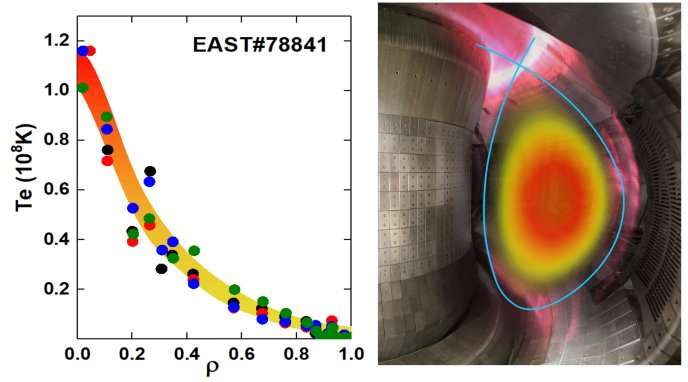
28th November 2018 Fusion experiment in China exceeds 100 million °C China's Institute of Plasma Physics has officially confirmed that plasma in the Experimental Advanced Superconducting Tokamak (EAST) exceeded 100 million degrees Celsius. The EAST, nicknamed the "Chinese artificial sun", achieved this milestone during a four-month experiment. Its electron temperature was about seven times hotter than the interior of the Sun, and shows that China is making significant progress towards tokamak-based fusion energy production. Tests were conducted by a team at the Hefei Institutes of Physical Science of the Chinese Academy of Sciences (CASHIPS) in collaboration with domestic and international colleagues. The plasma current density profile was optimised through effective integration and synergy of four kinds of heating power: lower hybrid wave heating, electron cyclotron wave heating, ion cyclotron resonance heating and neutral beam ion heating. Power injection exceeded 10 megawatts (MW), and plasma stored energy was boosted to 300 kilojoules (kJ) after scientists optimised the coupling of different heating techniques. Advanced plasma control and theory/simulation prediction were utilised during the experiment.
Scientists performed experiments on plasma equilibrium and instability, confinement and transport, plasma-wall interaction and energetic particle physics to demonstrate long-time scale, good control of impurity, core/edge stability, and heat exhaust using an ITER-like tungsten diverter. However, while the EAST reactor achieved an impressive temperature, with a discharge pulse of more than 100 seconds, there is still a long way to go before the creation of sustainable, commercial fusion energy. According to specialist Zhang Tiankan, future milestones will involve raising the temperature even higher to “hundreds of millions of degrees” and lengthening the pulse to “thousands of seconds”. “EAST is like an oven, but to achieve temperatures high enough for nuclear fusion, you need to either make the oven hotter or slow the heat radiation,” explained Wan Baonian, director of the Institute of Plasma Physics at the Chinese Academy of Sciences. “It is harder to achieve such temperatures at EAST, as it’s small compared with its peers. [By comparison], the ITER will in the future be able to achieve temperatures of 200 million degrees.”
Comments »
If you enjoyed this article, please consider sharing it:
|







